Acme Cola Company Ltd Negligence: A Detailed Case Study Analysis
VerifiedAdded on 2023/06/10
|6
|1521
|479
Case Study
AI Summary
This case study analyzes a potential negligence claim against Acme Cola Company Ltd following an incident where Andy consumed a cola bottle containing cockroach remains, leading to his illness and hospitalization. The analysis applies principles of tort law, specifically focusing on duty of care, breach of duty, causation, and damages. It examines whether Acme Cola, as the manufacturer, owed a duty of care to consumers like Andy and Sandra, and whether that duty was breached by providing a contaminated product. The study concludes that while Andy may have a valid claim for medical expenses due to Acme's negligence, Sandra's claim for lost wages is likely too remote to be considered a direct result of Acme's breach. The document refers to landmark cases such as Donoghue v Stevenson to support its arguments and provides a comprehensive overview of the legal principles involved.
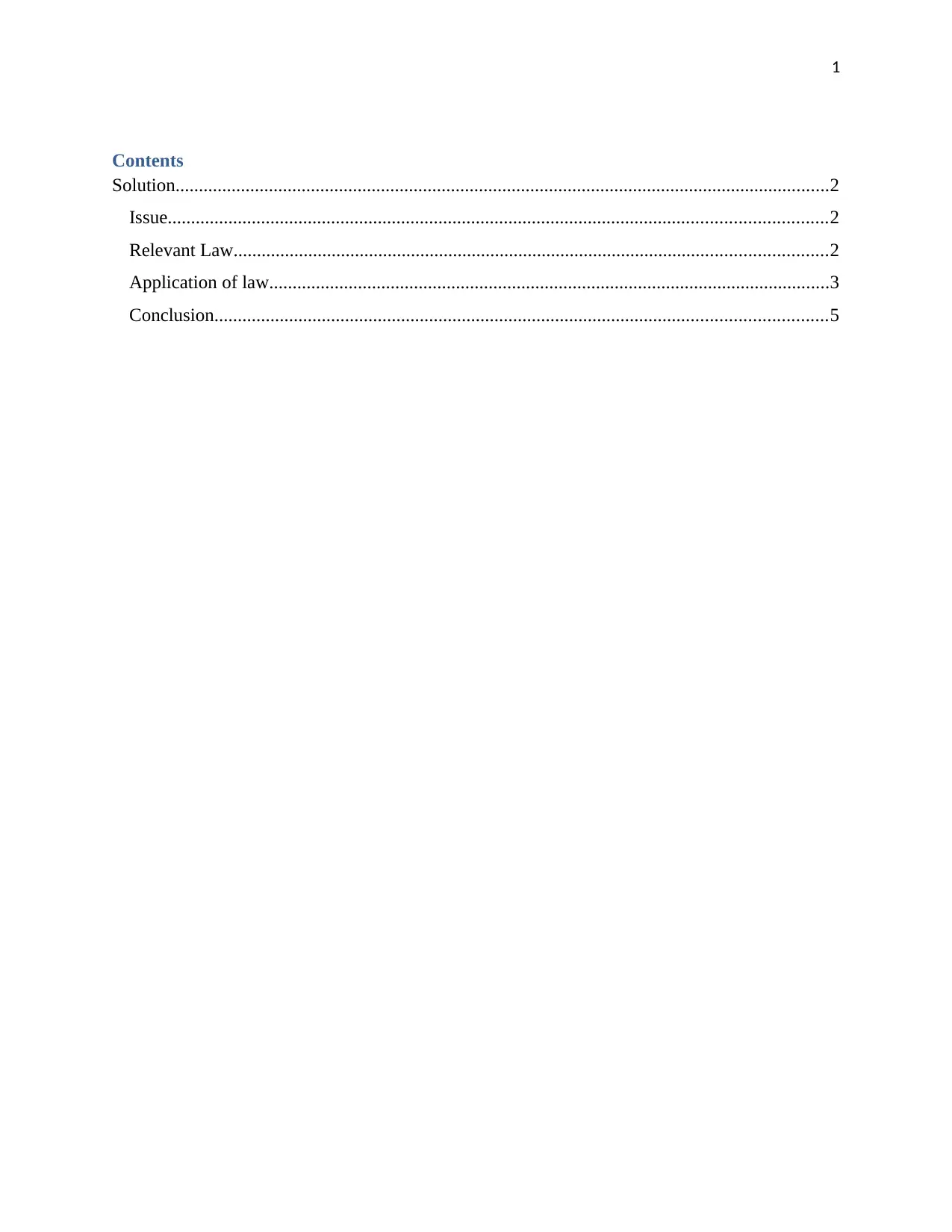
1
Contents
Solution............................................................................................................................................2
Issue.............................................................................................................................................2
Relevant Law...............................................................................................................................2
Application of law........................................................................................................................3
Conclusion...................................................................................................................................5
Contents
Solution............................................................................................................................................2
Issue.............................................................................................................................................2
Relevant Law...............................................................................................................................2
Application of law........................................................................................................................3
Conclusion...................................................................................................................................5
Paraphrase This Document
Need a fresh take? Get an instant paraphrase of this document with our AI Paraphraser
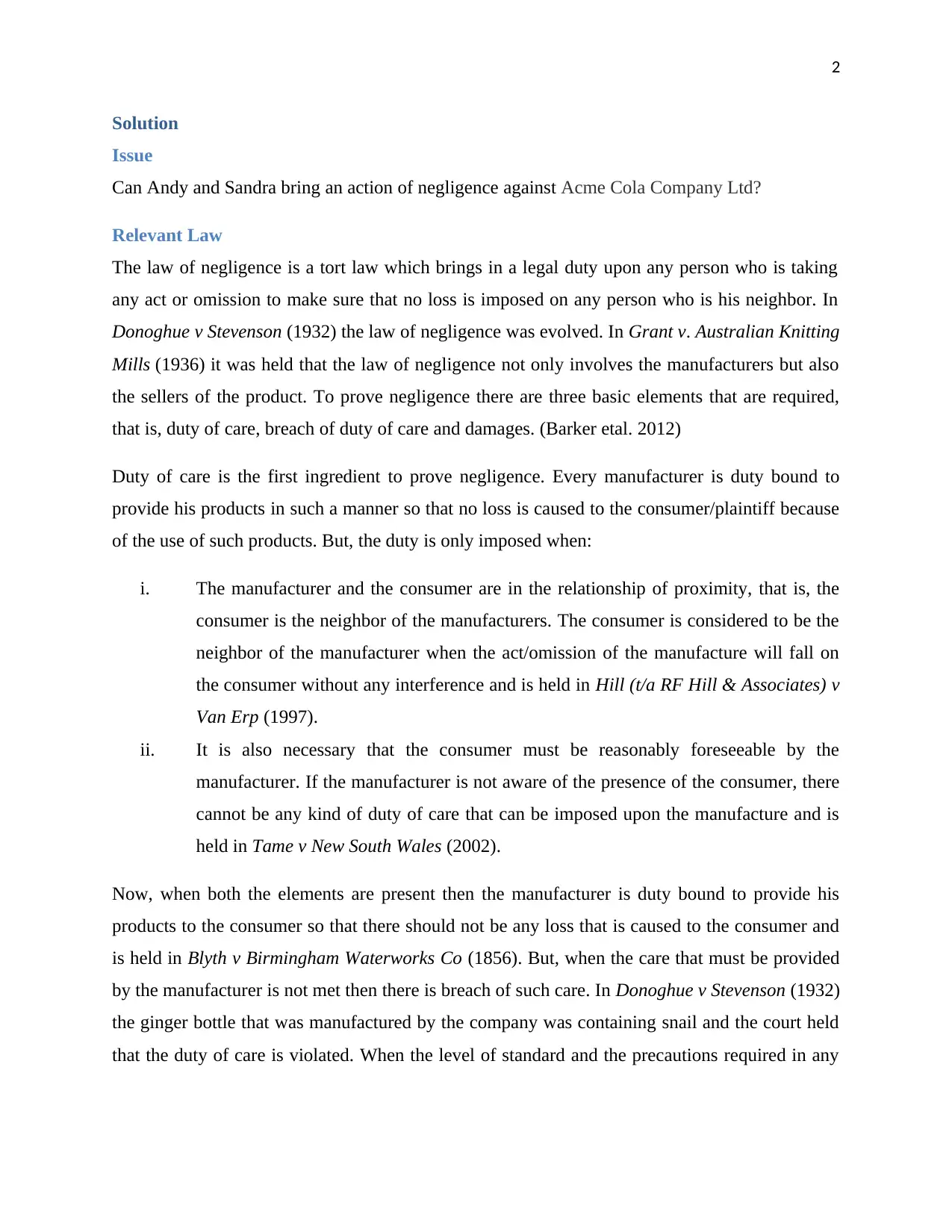
2
Solution
Issue
Can Andy and Sandra bring an action of negligence against Acme Cola Company Ltd?
Relevant Law
The law of negligence is a tort law which brings in a legal duty upon any person who is taking
any act or omission to make sure that no loss is imposed on any person who is his neighbor. In
Donoghue v Stevenson (1932) the law of negligence was evolved. In Grant v. Australian Knitting
Mills (1936) it was held that the law of negligence not only involves the manufacturers but also
the sellers of the product. To prove negligence there are three basic elements that are required,
that is, duty of care, breach of duty of care and damages. (Barker etal. 2012)
Duty of care is the first ingredient to prove negligence. Every manufacturer is duty bound to
provide his products in such a manner so that no loss is caused to the consumer/plaintiff because
of the use of such products. But, the duty is only imposed when:
i. The manufacturer and the consumer are in the relationship of proximity, that is, the
consumer is the neighbor of the manufacturers. The consumer is considered to be the
neighbor of the manufacturer when the act/omission of the manufacture will fall on
the consumer without any interference and is held in Hill (t/a RF Hill & Associates) v
Van Erp (1997).
ii. It is also necessary that the consumer must be reasonably foreseeable by the
manufacturer. If the manufacturer is not aware of the presence of the consumer, there
cannot be any kind of duty of care that can be imposed upon the manufacture and is
held in Tame v New South Wales (2002).
Now, when both the elements are present then the manufacturer is duty bound to provide his
products to the consumer so that there should not be any loss that is caused to the consumer and
is held in Blyth v Birmingham Waterworks Co (1856). But, when the care that must be provided
by the manufacturer is not met then there is breach of such care. In Donoghue v Stevenson (1932)
the ginger bottle that was manufactured by the company was containing snail and the court held
that the duty of care is violated. When the level of standard and the precautions required in any
Solution
Issue
Can Andy and Sandra bring an action of negligence against Acme Cola Company Ltd?
Relevant Law
The law of negligence is a tort law which brings in a legal duty upon any person who is taking
any act or omission to make sure that no loss is imposed on any person who is his neighbor. In
Donoghue v Stevenson (1932) the law of negligence was evolved. In Grant v. Australian Knitting
Mills (1936) it was held that the law of negligence not only involves the manufacturers but also
the sellers of the product. To prove negligence there are three basic elements that are required,
that is, duty of care, breach of duty of care and damages. (Barker etal. 2012)
Duty of care is the first ingredient to prove negligence. Every manufacturer is duty bound to
provide his products in such a manner so that no loss is caused to the consumer/plaintiff because
of the use of such products. But, the duty is only imposed when:
i. The manufacturer and the consumer are in the relationship of proximity, that is, the
consumer is the neighbor of the manufacturers. The consumer is considered to be the
neighbor of the manufacturer when the act/omission of the manufacture will fall on
the consumer without any interference and is held in Hill (t/a RF Hill & Associates) v
Van Erp (1997).
ii. It is also necessary that the consumer must be reasonably foreseeable by the
manufacturer. If the manufacturer is not aware of the presence of the consumer, there
cannot be any kind of duty of care that can be imposed upon the manufacture and is
held in Tame v New South Wales (2002).
Now, when both the elements are present then the manufacturer is duty bound to provide his
products to the consumer so that there should not be any loss that is caused to the consumer and
is held in Blyth v Birmingham Waterworks Co (1856). But, when the care that must be provided
by the manufacturer is not met then there is breach of such care. In Donoghue v Stevenson (1932)
the ginger bottle that was manufactured by the company was containing snail and the court held
that the duty of care is violated. When the level of standard and the precautions required in any
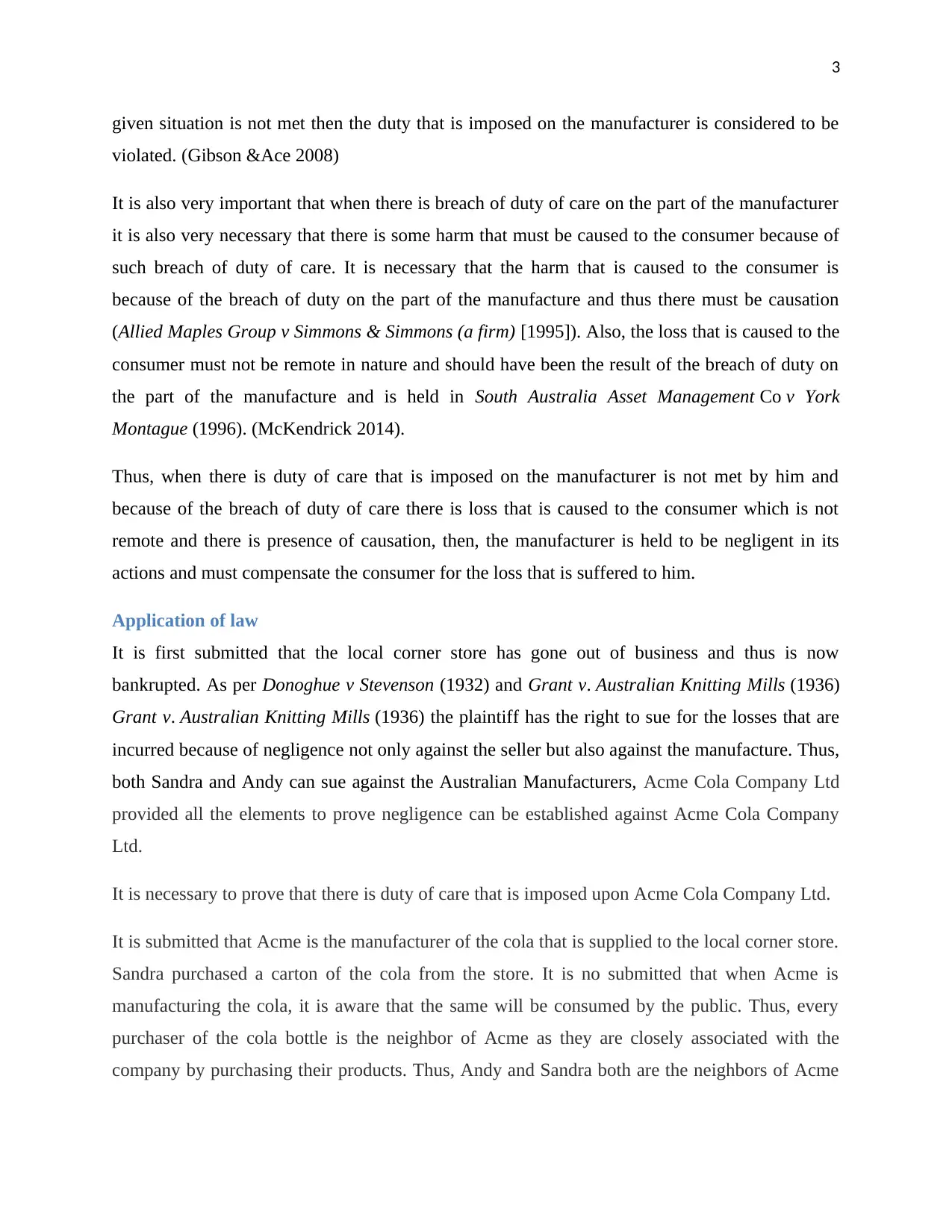
3
given situation is not met then the duty that is imposed on the manufacturer is considered to be
violated. (Gibson &Ace 2008)
It is also very important that when there is breach of duty of care on the part of the manufacturer
it is also very necessary that there is some harm that must be caused to the consumer because of
such breach of duty of care. It is necessary that the harm that is caused to the consumer is
because of the breach of duty on the part of the manufacture and thus there must be causation
(Allied Maples Group v Simmons & Simmons (a firm) [1995]). Also, the loss that is caused to the
consumer must not be remote in nature and should have been the result of the breach of duty on
the part of the manufacture and is held in South Australia Asset Management Co v York
Montague (1996). (McKendrick 2014).
Thus, when there is duty of care that is imposed on the manufacturer is not met by him and
because of the breach of duty of care there is loss that is caused to the consumer which is not
remote and there is presence of causation, then, the manufacturer is held to be negligent in its
actions and must compensate the consumer for the loss that is suffered to him.
Application of law
It is first submitted that the local corner store has gone out of business and thus is now
bankrupted. As per Donoghue v Stevenson (1932) and Grant v. Australian Knitting Mills (1936)
Grant v. Australian Knitting Mills (1936) the plaintiff has the right to sue for the losses that are
incurred because of negligence not only against the seller but also against the manufacture. Thus,
both Sandra and Andy can sue against the Australian Manufacturers, Acme Cola Company Ltd
provided all the elements to prove negligence can be established against Acme Cola Company
Ltd.
It is necessary to prove that there is duty of care that is imposed upon Acme Cola Company Ltd.
It is submitted that Acme is the manufacturer of the cola that is supplied to the local corner store.
Sandra purchased a carton of the cola from the store. It is no submitted that when Acme is
manufacturing the cola, it is aware that the same will be consumed by the public. Thus, every
purchaser of the cola bottle is the neighbor of Acme as they are closely associated with the
company by purchasing their products. Thus, Andy and Sandra both are the neighbors of Acme
given situation is not met then the duty that is imposed on the manufacturer is considered to be
violated. (Gibson &Ace 2008)
It is also very important that when there is breach of duty of care on the part of the manufacturer
it is also very necessary that there is some harm that must be caused to the consumer because of
such breach of duty of care. It is necessary that the harm that is caused to the consumer is
because of the breach of duty on the part of the manufacture and thus there must be causation
(Allied Maples Group v Simmons & Simmons (a firm) [1995]). Also, the loss that is caused to the
consumer must not be remote in nature and should have been the result of the breach of duty on
the part of the manufacture and is held in South Australia Asset Management Co v York
Montague (1996). (McKendrick 2014).
Thus, when there is duty of care that is imposed on the manufacturer is not met by him and
because of the breach of duty of care there is loss that is caused to the consumer which is not
remote and there is presence of causation, then, the manufacturer is held to be negligent in its
actions and must compensate the consumer for the loss that is suffered to him.
Application of law
It is first submitted that the local corner store has gone out of business and thus is now
bankrupted. As per Donoghue v Stevenson (1932) and Grant v. Australian Knitting Mills (1936)
Grant v. Australian Knitting Mills (1936) the plaintiff has the right to sue for the losses that are
incurred because of negligence not only against the seller but also against the manufacture. Thus,
both Sandra and Andy can sue against the Australian Manufacturers, Acme Cola Company Ltd
provided all the elements to prove negligence can be established against Acme Cola Company
Ltd.
It is necessary to prove that there is duty of care that is imposed upon Acme Cola Company Ltd.
It is submitted that Acme is the manufacturer of the cola that is supplied to the local corner store.
Sandra purchased a carton of the cola from the store. It is no submitted that when Acme is
manufacturing the cola, it is aware that the same will be consumed by the public. Thus, every
purchaser of the cola bottle is the neighbor of Acme as they are closely associated with the
company by purchasing their products. Thus, Andy and Sandra both are the neighbors of Acme
⊘ This is a preview!⊘
Do you want full access?
Subscribe today to unlock all pages.

Trusted by 1+ million students worldwide
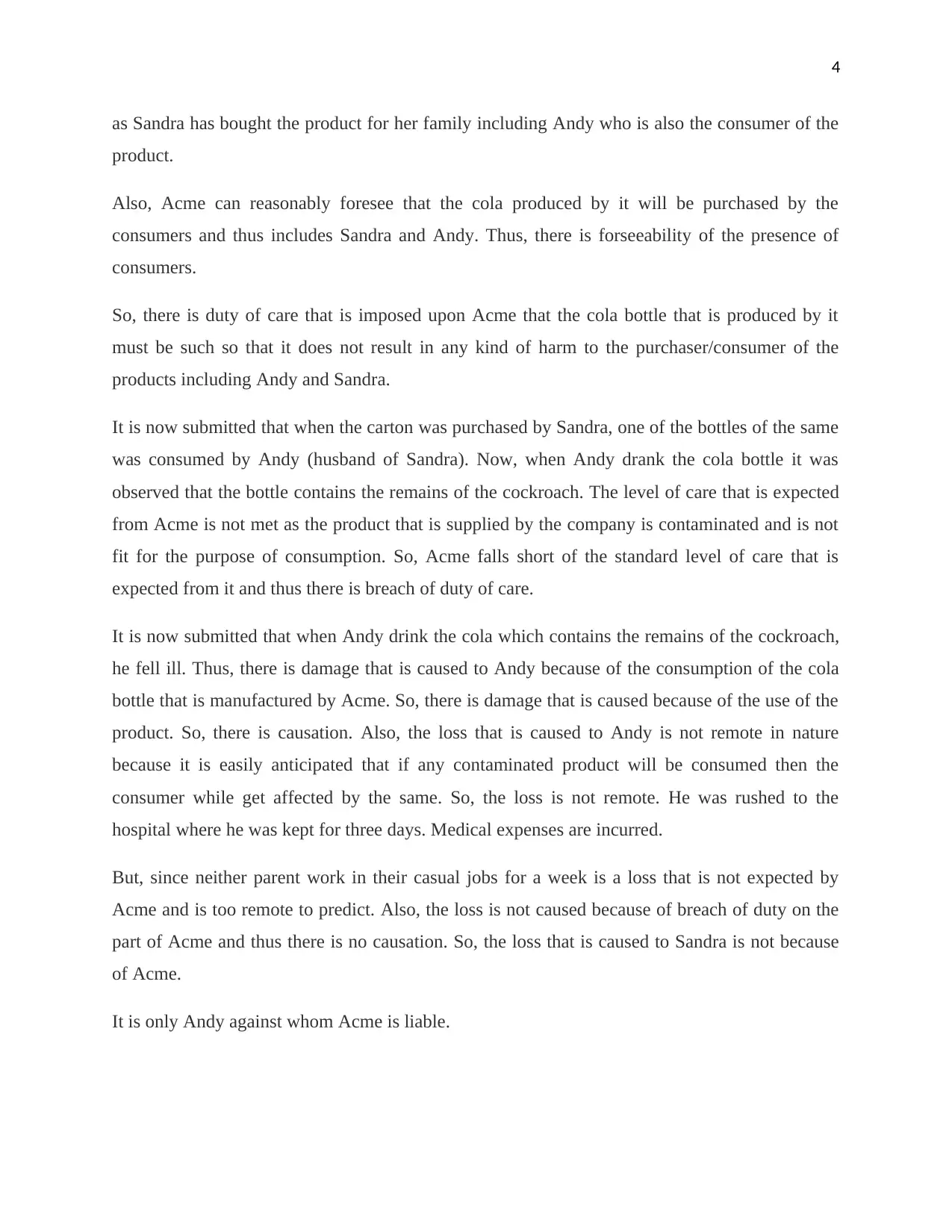
4
as Sandra has bought the product for her family including Andy who is also the consumer of the
product.
Also, Acme can reasonably foresee that the cola produced by it will be purchased by the
consumers and thus includes Sandra and Andy. Thus, there is forseeability of the presence of
consumers.
So, there is duty of care that is imposed upon Acme that the cola bottle that is produced by it
must be such so that it does not result in any kind of harm to the purchaser/consumer of the
products including Andy and Sandra.
It is now submitted that when the carton was purchased by Sandra, one of the bottles of the same
was consumed by Andy (husband of Sandra). Now, when Andy drank the cola bottle it was
observed that the bottle contains the remains of the cockroach. The level of care that is expected
from Acme is not met as the product that is supplied by the company is contaminated and is not
fit for the purpose of consumption. So, Acme falls short of the standard level of care that is
expected from it and thus there is breach of duty of care.
It is now submitted that when Andy drink the cola which contains the remains of the cockroach,
he fell ill. Thus, there is damage that is caused to Andy because of the consumption of the cola
bottle that is manufactured by Acme. So, there is damage that is caused because of the use of the
product. So, there is causation. Also, the loss that is caused to Andy is not remote in nature
because it is easily anticipated that if any contaminated product will be consumed then the
consumer while get affected by the same. So, the loss is not remote. He was rushed to the
hospital where he was kept for three days. Medical expenses are incurred.
But, since neither parent work in their casual jobs for a week is a loss that is not expected by
Acme and is too remote to predict. Also, the loss is not caused because of breach of duty on the
part of Acme and thus there is no causation. So, the loss that is caused to Sandra is not because
of Acme.
It is only Andy against whom Acme is liable.
as Sandra has bought the product for her family including Andy who is also the consumer of the
product.
Also, Acme can reasonably foresee that the cola produced by it will be purchased by the
consumers and thus includes Sandra and Andy. Thus, there is forseeability of the presence of
consumers.
So, there is duty of care that is imposed upon Acme that the cola bottle that is produced by it
must be such so that it does not result in any kind of harm to the purchaser/consumer of the
products including Andy and Sandra.
It is now submitted that when the carton was purchased by Sandra, one of the bottles of the same
was consumed by Andy (husband of Sandra). Now, when Andy drank the cola bottle it was
observed that the bottle contains the remains of the cockroach. The level of care that is expected
from Acme is not met as the product that is supplied by the company is contaminated and is not
fit for the purpose of consumption. So, Acme falls short of the standard level of care that is
expected from it and thus there is breach of duty of care.
It is now submitted that when Andy drink the cola which contains the remains of the cockroach,
he fell ill. Thus, there is damage that is caused to Andy because of the consumption of the cola
bottle that is manufactured by Acme. So, there is damage that is caused because of the use of the
product. So, there is causation. Also, the loss that is caused to Andy is not remote in nature
because it is easily anticipated that if any contaminated product will be consumed then the
consumer while get affected by the same. So, the loss is not remote. He was rushed to the
hospital where he was kept for three days. Medical expenses are incurred.
But, since neither parent work in their casual jobs for a week is a loss that is not expected by
Acme and is too remote to predict. Also, the loss is not caused because of breach of duty on the
part of Acme and thus there is no causation. So, the loss that is caused to Sandra is not because
of Acme.
It is only Andy against whom Acme is liable.
Paraphrase This Document
Need a fresh take? Get an instant paraphrase of this document with our AI Paraphraser
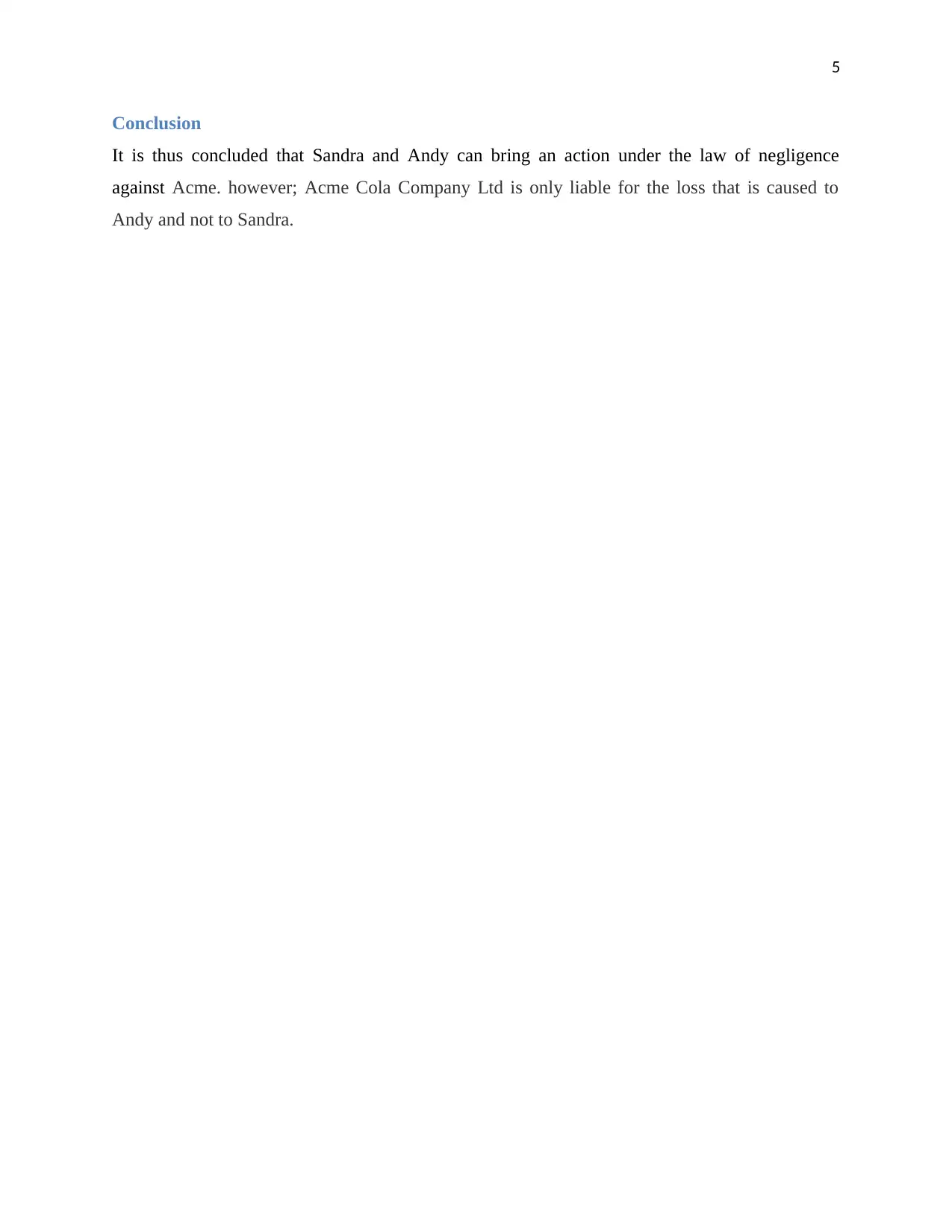
5
Conclusion
It is thus concluded that Sandra and Andy can bring an action under the law of negligence
against Acme. however; Acme Cola Company Ltd is only liable for the loss that is caused to
Andy and not to Sandra.
Conclusion
It is thus concluded that Sandra and Andy can bring an action under the law of negligence
against Acme. however; Acme Cola Company Ltd is only liable for the loss that is caused to
Andy and not to Sandra.
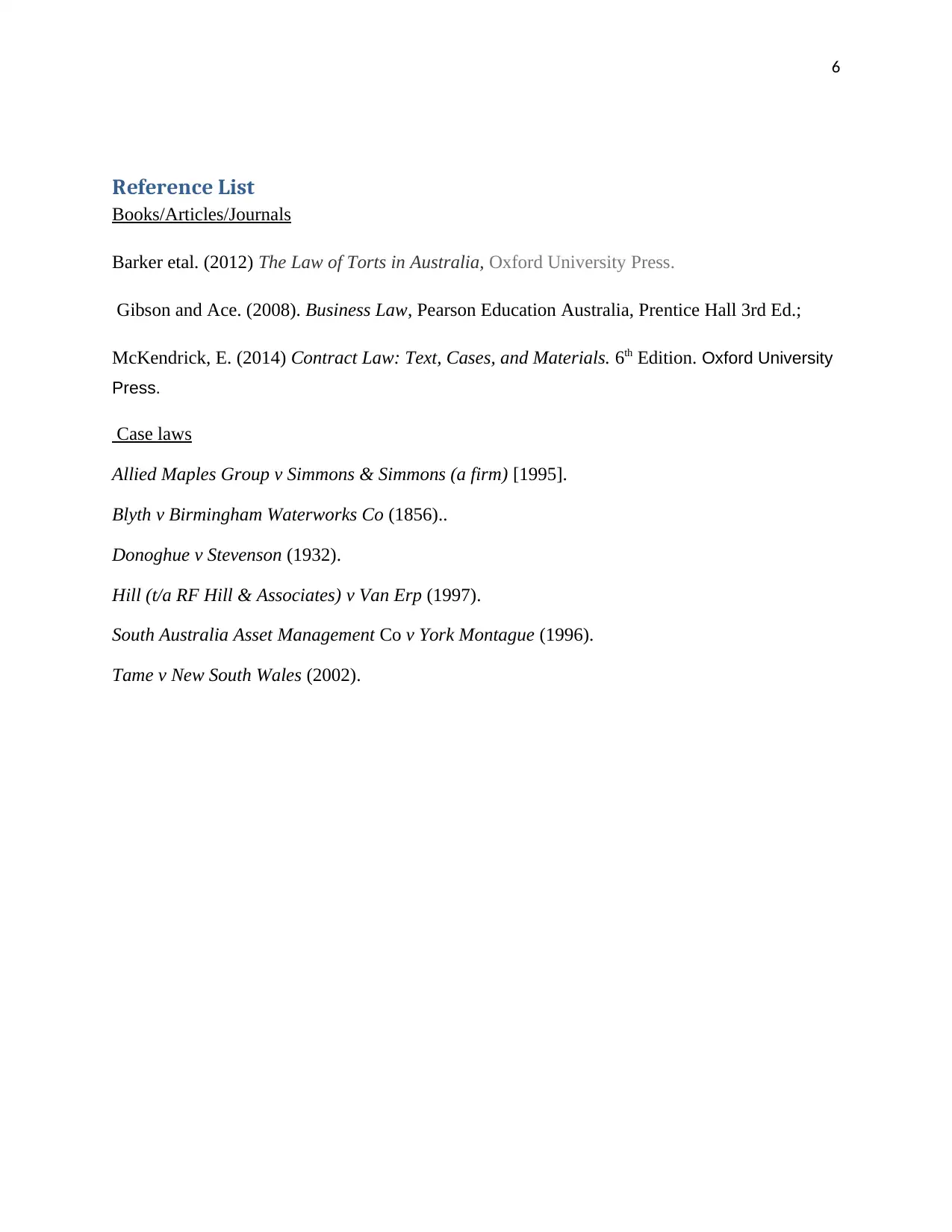
6
Reference List
Books/Articles/Journals
Barker etal. (2012) The Law of Torts in Australia, Oxford University Press.
Gibson and Ace. (2008). Business Law, Pearson Education Australia, Prentice Hall 3rd Ed.;
McKendrick, E. (2014) Contract Law: Text, Cases, and Materials. 6th Edition. Oxford University
Press.
Case laws
Allied Maples Group v Simmons & Simmons (a firm) [1995].
Blyth v Birmingham Waterworks Co (1856)..
Donoghue v Stevenson (1932).
Hill (t/a RF Hill & Associates) v Van Erp (1997).
South Australia Asset Management Co v York Montague (1996).
Tame v New South Wales (2002).
Reference List
Books/Articles/Journals
Barker etal. (2012) The Law of Torts in Australia, Oxford University Press.
Gibson and Ace. (2008). Business Law, Pearson Education Australia, Prentice Hall 3rd Ed.;
McKendrick, E. (2014) Contract Law: Text, Cases, and Materials. 6th Edition. Oxford University
Press.
Case laws
Allied Maples Group v Simmons & Simmons (a firm) [1995].
Blyth v Birmingham Waterworks Co (1856)..
Donoghue v Stevenson (1932).
Hill (t/a RF Hill & Associates) v Van Erp (1997).
South Australia Asset Management Co v York Montague (1996).
Tame v New South Wales (2002).
⊘ This is a preview!⊘
Do you want full access?
Subscribe today to unlock all pages.

Trusted by 1+ million students worldwide
1 out of 6
Related Documents
Your All-in-One AI-Powered Toolkit for Academic Success.
+13062052269
info@desklib.com
Available 24*7 on WhatsApp / Email
![[object Object]](/_next/static/media/star-bottom.7253800d.svg)
Unlock your academic potential
Copyright © 2020–2025 A2Z Services. All Rights Reserved. Developed and managed by ZUCOL.




